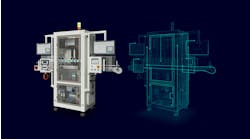The very first project I worked on in 1981 was a lumber mill’s trimmer/sorter and bundle creator. It was a relay-controlled system that was converted to PLC-based control. The I/O had to be defined and identified on the PLC modules, and of course the drawings had to be created.
It took a week from start to finish, allocating the I/O, installing the PLC hardware, doing an I/O check and performing the implementation. Whew! And it almost worked, but that’s another story.
Also read: Computer-aided-design software draws on the concept of innovation
I remember waking up in an office after resting my head on a drafting board that we used for creating the drawings for the electricians to wire the I/O. A drafting board and a T-square. Yep, I could be that old.
Most in automation have not had the privilege of using said board, along with something called a slide rule since calculators replaced them in the 1970s.
Fast forward to 1979, when a product called Interact CAD by a company called Autodesk. It quickly became the de facto standard for mechanical system design for projects of varying disciplines. It was also used for electrical drawings such as single-line and three-phase drawings, as well as PLC-based drawings.
When I was the product manager for a PLC programming software company, there was collaboration with a Canadian company that produced an automatic I/O generation drawing package for Allen-Bradley and Modicon PLC projects. The company used the built-in AutoCAD LISP programming language to automate certain tasks.
I/O drawings could now be produced in AutoCAD in minutes, instead of days. Most developers had already created templates for static drawings, but the automatic line numbering and wire markers still had to be done manually. A good step forward, however.
AutoCAD Electrical became available in 1982 and was very rudimentary in the beginning. Remember the IBM PC only became available in 1981. Memory costs and hard drive space were expensive, as were the computers themselves.
And the ECAD market was born.
As time, technology and reduced hardware costs came together, many additional vendors came into the market to create a very viable option; and drafting boards and machines became a staple at industrial garage sales.
One of the premises of software development on any level is the idea of “enter once, use many times.”
When you identify an output device—name/tag, device type, location, voltage—its data should be collected in one space and then accessed by other software systems in order to populate data fields as required.
When it comes to ECAD systems, they have come a long way in automating mundane processes by utilizing software platforms such as spreadsheets or databases of various types.
The spreadsheet is probably the most common method of “enter once, use many.” AutoCAD Electrical has a spreadsheet import function built into the application so that accessing the data is pretty easy. Eplan P8 also has this function that has more than 70 specific data points in the parts management database. Automating I/O drawings with specific module representations for various PLC vendors is a function that sets P8 apart from others.
Radica is another ECAD solution for automation and is cloud-based. It used to be Visio-based, which required a very manual function level but now automates many of its functions by utilizing drag and drop of symbols that can be user-created.
The benefits of ECAD software move way past just I/O drawings and electrical layouts. Because of the “enter once, use many” mentality, bill-of-materials (BOM) reports can be generated, as well as panel layouts, parts lists, cross-reference reports and wiring lists, among other functions and reports.
What used to be simply PLC-related drawings and reports has morphed into so much more.
The learning curves for most systems are not linear as such. It takes more than a few hours to master the art of system design when using ECAD. It forces the user into taking a 1,000-foot view of the project first in order to efficiently use the software and all of its tools and automation.
Some solutions have the ability to export designs to 3D systems for mechanical systems to allow for 3D printing of prototypes. In fact, 3D design systems are required for machine builders of all ilks. Back in the day, 3D functionality required a large investment in computer hardware. However today 3D programs such as SolidWorks can function quite nicely on a PC-based platform.
My days of sleeping on a drafting board are over thankfully. The progression of ECAD software has made my early bed obsolete.






